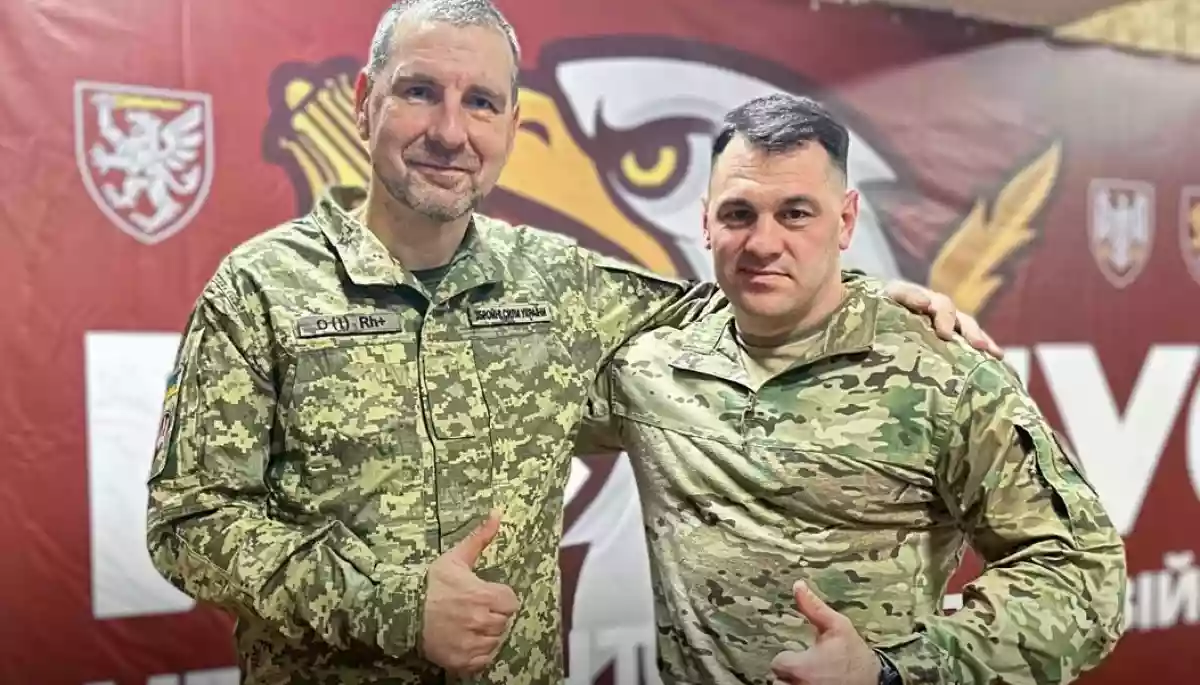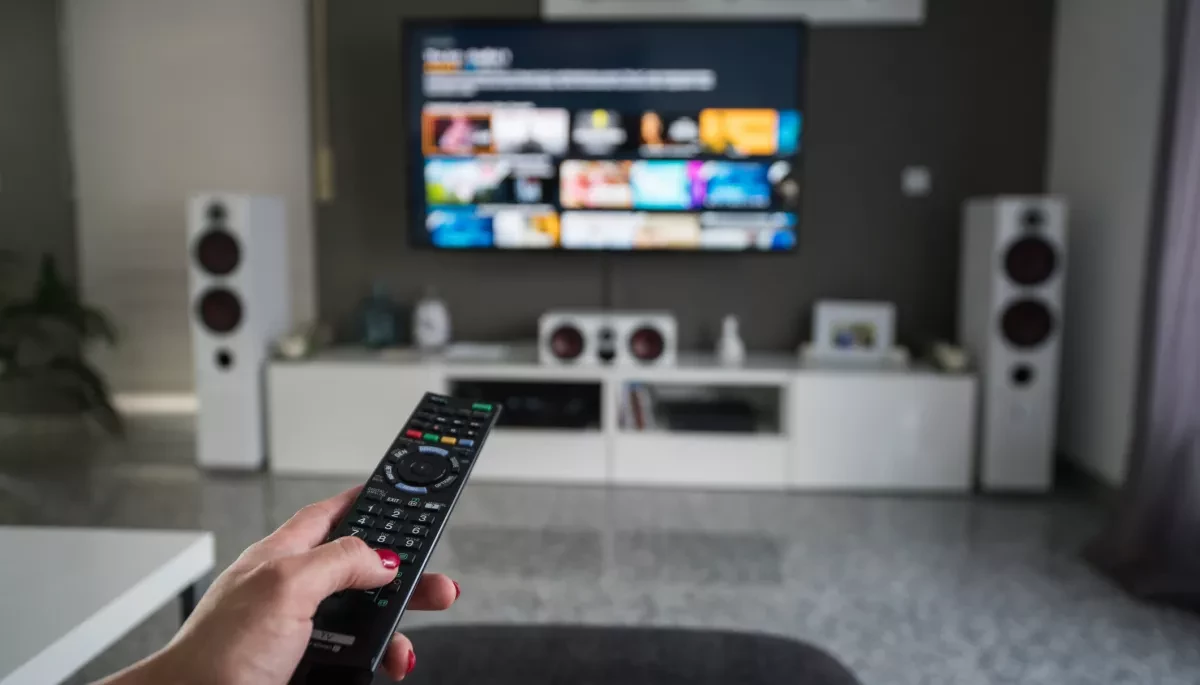
The main trends in the daily news of all-Ukrainian TV channels in 2019-2021
The main trends in the daily news of all-Ukrainian TV channels in 2019-2021
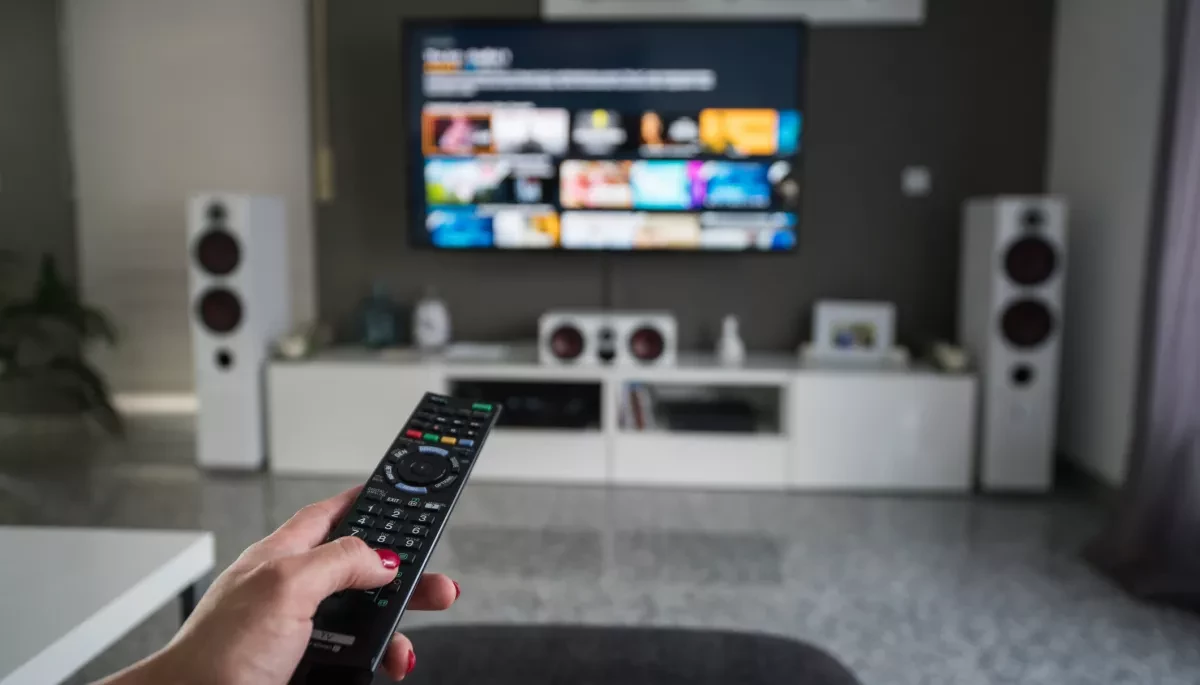

The Detector Media NGO (until 2016 - Telekritika) has been continuously monitoring the news by central television channels since 2003. At first, it was a qualitative analysis with an emphasis on manipulation and "information special operations" that often occurred on government-controlled television in 2003-2004. Later, the quantitative component appeared in the monitoring; it focused on the study of journalistic standards and materials with signs of order, and since 2015 we have supplemented it with an in-depth quantitative and qualitative study called "What TV News Was Silent About". The first author to formulate the concept and approaches to monitoring by Telekritika/Detector Media was media manager and media coach Ihor Kulyas. In 2018, his approaches were formalized in the form of a large Methodology of monitoring television and radio programs of the Detector Media NGO (news, summarizing weekly newscasts, publicistic authorial programs, political talk shows, interviews). Since November 2016, Zoya Krasovska has been the main author and coordinator of the news monitoring. Analytical texts were the traditional form of publishing the weekly results of the monitoring research. In early 2019, we decided to expand the research by collecting information and assessments of compliance with standards in individual materials of the channels from the monitoring sample to the database. At that time, there were eight TV channels in the monitoring sample: 1+1, Inter, ICTV, STB, Channel Ukraine, UA: Pershyi, Channel 5 and Channel 112 (from 2021 - Pershyi Nezalezhnyi). In January 2022, the Detector Media NGO presented NewsBoard interactive tool which uses this database to visualize and analyze various aspects of the quality and content of news from eight TV channels.
We would like to note that the sample of the study includes all the materials of the prime (main) newscasts of these TV channels. In addition, most of the channels broadcast several more newscasts during the day. Therefore, research figures are not important as absolute indicators, but in comparison. This report will cover trends that we have been tracking for three years.
We started collecting data in the database in early 2019, in the midst of the presidential election campaign. Summarizing the next three years is a difficult task, as Ukraine's political realities have changed completely, and these changes have had a profound effect on the political landscape. The situation on the television market has also changed: In three years, the niche of news channels has significantly strengthened and expanded, the leading players have changed - the triad of channels of Medvedchuk (112, ZIK and NewsOne) have disappeared, Rinat Akhmetov's Ukraine 24 channel has appeared, and Yevheniy Murayev's Nash channel has strengthened. At the same time, the Inter channel, which at the beginning of 2019 still played a huge role in the information space, was marginalized and lost its position. At the same time, the situation with materials with signs of order has not changed much. Comparing the results of 2018 and 2021, we see two leaders in the amount of PR in the news: Inter and Ukraine. These two channels typically account for more than half of the suspicious material recorded during the week or month. At the same time, in 2021, the Pershyi Nezalezhnyi channel (until March 2021 - "112") and Channel 5, which at the beginning of the analyzed period almost had no materials with signs of order in news, took the third and fourth places, overtaking ICTV and 1+1. These channels were mobilized in support of their now informal owners, the groups of Viktor Medvedchuk a,d Petro Poroshenko and European Solidarity respectively. The ratio of the number of suspicious materials in the news of the two "leading" channels of the rating and the channels ICTV and 1+1 also remains more or less stable. As well as the almost complete absence of such materials in the news of the public broadcaster's channel (single recorded cases can be attributed to journalistic errors).
In February-May 2019, the presidential campaign continued, and most TV channels, except for 1+1, remained loyal to the incumbent President Petro Poroshenko. In March, Poroshenko not only topped the list of television news by number of times being mentioned, but was well ahead of his closest rival, Yulia Tymoshenko; Volodymyr Zelenskyi was five times behind Poroshenko in the number of mentions, and a significant part of the mentions of him was provided by the 1+1 channel. While Channels 5 and 112 did not mention the top-ranked candidate in the news at all. In April, the number of mentions of Petro Poroshenko and Volodymyr Zelenskyi almost equaled; Yulia Tymoshenko and Yuriy Boyko were in third and fourth places, followed by Oleh Liashko, Anatoliy Hrytsenko and Oleksandr Vilkul. In May, after the election results became clear, we saw a total reorientation of television news to newly elected President Volodymyr Zelenskyi, as well as his Servant of the People party, which at the time existed only on paper. Despite its formal status, the Servant of the People became the most mentioned political force in the news in May, overtaking the then-Petro Poroshenko Bloc parliamentary party. Data about attention to specific politicians - presidential candidates - were important in the first months of filling the database; then the indicator of attention to political forces became more important.
The key political forces whose presence we measure in the news since the autumn of 2019 are parliamentary parties (others are almost never mentioned in TV news) which can be divided into two categories:
Parties affiliated with media groups. First of all, it is the Opposition Platform - For Life party, which does not leave the top three rankings of alleged PR customers in television news in this period. At the same time, these indicators are ensured by the presence on only two television channels of the sample - Inter and 112 (from 2021, the Pershyi Nezalezhnyi channel); other channels never promote this party, and the channels of Pinchuk's group (ICTV and STB), Ukraine channel and 1+1 avoid mentioning it, even in a neutral context. This is a unique situation, the analogues of which existed on Ukrainian television only in the last years of Kuchma's presidency: one of the main opposition forces is completely excluded from the information picture offered to its viewers by leading television channels. Regular viewers of these channels may not even know that there is the Opposition Platform - For Life party in the Ukrainian parliament. At the same time, in the news by "their" TV channels, the Opposition Platform - For Life party takes up so much air time that there is almost no left for other parties; viewers of these channels may think that this party dominates in Ukrainian politics.
It should be noted that the merger of Inter and 112/the Pershyi Nezalezhnyi into the Opposition Platform - For Life party's group is quite conditional, as Inter and Medvedchuk's channels (112, ZIK and NewsOne) belong to the two wings of the party. Therefore, the faces of the speakers in the news of these two groups are traditionally different. Yuriy Boyko, Yulia Liovochkina (sister of co-owner of the channel Serhiy Liovochkin), Nataliya Korolevska and Mykola Skoryk are most often mentioned on Inter; on 112 / the Pershyi Nezalezhnyi - Viktor Medvedchuk, Nestor Shufrych, Vadym Rabynovych, Oleksandr Kachnyi and Illia Kyva. The appearance of speakers from Medvedchuk's group on the air of Inter or speakers from Boyko-Liovochkin's group on 112/the Pershyi Nezalezhnyi was quite rare during this period, although Inter generally supported Viktor Medvedchuk when sanctions were imposed on him and criminal proceedings were started. The common thrust of the Opposition Platform - For Life party channels' news was the promotion of the Russian Sputnik V vaccine in autumn and winter 2020, but, for example, the topic of "attack on freedom of speech" in connection with the closure of Medvedchuk's channels was promoted much less by Inter than by the Pershyi Nezalezhnyi.
The European Solidarity party (until the end of the summer of 2019, Petro Poroshenko's Bloc) most often appears naturally in the news of Channel 5, which belongs to Petro Poroshenko. However, the transformation of Channel 5 into a platform for aggressive PR of the owner and his party was gradual and was completed in the fall of 2020, during the local elections. It can be assumed that the journalistic standards set in the editorial policy of Channel 5 during the Orange Revolution were not a mere name, so the channel's news remained relatively pure for a longer time than, for example, on Priamyi Channel - another information broadcaster related to Poroshenko and the European Solidarity party. It is noteworthy that after the formal change of ownership, when in November 2021 Channel 5 and Priamyi were transferred to the newly created Free Media holding, the number of Poroshenko's and European Solidarity party's PR even increased.
The European Solidarity party in different periods became "popular" (i.e. mentioned more often than usual) on channels Ukraine, Inter and on Pinchuk's channels - ICTV and STB. At the end of 2021, there was a certain commitment to Petro Poroshenko and his party on the Ukraine television channel.
The For the Future party is a political force that is focused on Ihor Kolomoiskyi. This party emerged after the 2019 elections, so the group of the same name in the parliament included majority deputies and exiles from the Servants of the People. The only platform for PR of this party in all-Ukrainian television news is Kolomoiskyi's 1+1 channel; other channels mention it much less often and only for good reasons - for example, a sharp increase in the number of mentions of the For the Future party was because of the death of MP Anton Poliakov. As the 1+1 television channel remains loyal to Volodymyr Zelenskyi and his team, in conflict situations when representatives of the For the Future party and the Servants of the People party competed in the election, the channel mostly sided with the former, but did not scandalize or escalate the conflict.
Parties that enjoy the sporadic support of media groups. These are the Servant of the People party, Batkivshchyna party and the Voice party - parliamentary political forces that do not have their own media resources, but the attention of the news of some TV channels to them has sharpened in certain periods.
The Servant of the People party formed a mono-majority in the parliament in early autumn 2019, so the increased attention of journalists to it is justified - it is from the representatives of this party that most of the effective legislative initiatives come. However, the Servant of the People party is not always in the first place in terms of the number of mentions in the news. In some cases, the Opposition Platform for Life party and European Solidarity party push the single-party majority to the third place by exploiting own and loyal TV channels.
It would be logical to expect special loyalty to the Servant of the People party from the 1+1 channel, which was the only one to support Volodymyr Zelenskyi during the 2019 campaign and openly identify with his team, and a number of journalists and channel's managers joined the party of the newly elected President and made it to the Verkhovna Rada. However, the situation here was much less clear: the overwhelming PR of the Servant of the People party is gradually narrowing to the spot support of people's deputies from the group focused on Ihor Kolomoisky. Or the concealment of negative information about them - for example, in the news by 1+1 they did not talk about the sanctions imposed in America against Oleksandr Dubinskyi, People's Deputy from the Servant of the People and the host of the channel. At the same time, since the fall of 2019, some negative articles about People's Deputies from the Servant of the People, such as Mykola Tyshchenko have appeared in the 1+1 news. Remaining supportive of the president's team, at least in the news by 1+1 did not become a platform for PR and promotion of the Servant of the People party.
Following the results of 2021, ICTV and channel Ukraine showed the greatest commitment to the "servants" - although the Ukraine channel moved from the category of loyal to the sharply oppositional in the fall. As for the materials with signs of order, the Servant of the People party in comparison with other "parties of power" that existed in Ukraine in the past - the Petro Poroshenko Bloc, the Party of Regions, Our Ukraine party, the Yulia Tymoshenko Bloc and older - has quite a small amount of PR. We can assume that in the first place in Zelenskyi's team is the personal image of the president, not the popularity of the party brand.
It is safe to say that the Voice party was particularly favored by Viktor Pinchuk's TV channels (STB and ICTV). It was on these channels that the party was most often mentioned in a positive light. At the same time, the problems within the party - the leaving of Serhiy Prytula, the separation of some members of the faction into the Solidarity group, and the struggle for leadership - were emphatically ignored by these channels. In 2021, this trend has reversed: Currently, the only TV channel that situationally demonstrates its commitment to the Voice party in the Detector Media sample is Channel 5.
The Batkivshchyna party appears more or less stably in a positive context in the news of the channels Ukraine, Inter and of the Pinchuk's group. At the same time, it should be noted that attention to this party is limited by the very niche that the Batkivshchyna party has occupied in Ukrainian politics. In fact, it is not in sharp opposition to the government, most public statements cover several important topics for the party (fight against the coronavirus epidemic, market of land, "tariff genocide"), and in many cases the Batkivshchyna party simply has nothing to add to political discussions which are covered in the news.
Non-parliamentary parties and politicians. In addition to assisting parliamentary political forces, channels Ukraine and Inter regularly mentioned and promoted several politicians outside parliament during the period under review. On channel Ukraine, it is the leader of the Radical Party of Ukraine Oleh Lyashko, the leader of the Hroysman Strategy party Volodymyr Hroysman, the leader of the Narodnyi Front party Arseniy Yatsenyuk, the leader of the Force and Honor party Ihor Smeshko, and since autumn 2021 the former chairman of the Verkhovna Rada, now non-partisan Dmytro Razumkov, who announced the creation of the Razumkov Team political force. MPs and politicians oriented on Rinat Akhmetov's - Borys Kolesnikov, Vadym Novynsky and others - appear less regularly in the Ukraine channel's news. The "Opposition Bloc" political brand, which Akhmetov and his media supported in the 2019 parliamentary elections, is no longer relevant, although former representatives of this party are mentioned in the news.
Serhiy Kaplin, a former MP who ran for mayor of Poltava in 2020, regularly appears on the Inter channel. Also here, the leader of the "National Corps" Andriy Biletskyi is relatively often invited to speak. In 2019, Inter's favorite was also MP Serhiy Rudyk, who eventually "drifted" in the Verkhovna Rada to Ihor Kolomoiskyi's For the Future group and lost Inter's commitment.
It is important to note that all these politicians and parties are never or almost never mentioned on other television channels and do not take a real part in the political process, i.e. journalists artificially fit them into the information context. The only exceptions are Vitaliy Klychko, the mayor of Kyiv and a political ally of the European Solidarity party, who appears in a positive light on the same channels as Petro Poroshenko and his party, and usually with real news.
Materials of official nature of the first persons of the state. The trend remained unchanged here after a complete change of the state's leadership: TV journalists consider it their duty to broadcast official statements and protocol events with the participation of the President, as well as to show in a positive way the events and phenomena he emphasizes (for example, the Great Construction program). At the same time, all channels, except the "party-related" Channel 5, Priamyi and Pershyi Nezalezhnyi, have an informal "non-aggression pact", which existed during Poroshenko's time - personal criticism of the President by both journalists and political opponents is almost missing. And the most inconvenient topics and events for the President and his team are omitted or incomplete (examples of such omissions from Zelenskyi's term are the accusations of Andriy Yermak by Geo Leros, "Wagnergate" and the results of the Quarter 95 offshore investigation).
The difference between President Poroshenko and President Zelenskyi is in the intensity of PR: If the fifth president has always competed with Rinat Akhmetov and Prime Minister Volodymyr Hroysman for first place in the ranking of alleged customers who order materials, the number of laudatory and official materials with Zelenskyi's participation after the 2019 parliamentary elections is always moderate: he never came close to leading the rankings. Bursts of TV attention to the Great Construction program were observed in May-June 2021, but were not long. In some months, the monitoring recorded only a few such materials scattered on various TV channels, and more than once, his wife Olena Zelenska, whom the channels like to show in the context of her social projects, was ahead of Volodymyr Zelenskyi concerning materials with signs of ordering.
Another radical change was the de facto absence of the head of government in the news. In 2018, Prime Minister Volodymyr Hroysman competed and even surpassed President Petro Poroshenko in the number of materials of official nature in the news. The prime ministers of Zelenskyi's time - Oleksiy Honcharuk and especially Denis Shmygal - almost did not appear in the lists of alleged customers of news with signs of order. Shmygal does not appear in the news as a public politician; he distances himself as much as possible from political conflicts, and does not make special statements to the press.
During these three years (as well as the previous decade) the servicing of business interests and the formation of a positive image of the owners of oligarchic TV channels remains unchanged. A prominent place here is occupied by Rinat Akhmetov, to whom at least one PR material (often more) is devoted every day in the news by the Ukraine channel. It is usually dedicated to the charity of the Rinat Akhmetov Foundation, the important role of its business in the Ukrainian economy, less often to the Shakhtar football club. In Inter news with much less intensity but almost every week, Dmytro Firtash (co-owner of the channel) and his company appeared, and Viktor Pinchuk and his company or charitable foundation appeared on ICTV and STB news. It is noteworthy that in the summer of 2021, when de-oligarchization was seriously discussed at the level of the President and the Verkhovna Rada, the number of positive image stories about Akhmetov on channel Ukraine and Firtash on Inter increased sharply.
Many news items of oligarchic media groups can be understood only in the context of the interests of the owners of these television channels, as well as the conflicts between them. In particular, Inter regularly broadcasts stories related to various regulatory aspects of import, export and taxation of the chemical industry, including the production of fertilizers. An important player in this market is Dmytro Firtash, who thus "sends greetings" to the government and competitors. Or, for example, in the fall of 2019, a correspondence "war" broke out between Akhmetov's and Kolomoiskyi's groups in the news: 1+1 pedaled the "Rotterdam+" topic and Rinat Akhmetov's responsibility for the abuse of the coal market during the presidency of Petro Poroshenko, and channel Ukraine at the same time accused Kolomoiskyi of creating a "corruption scheme" in the same market. Later, such confrontations on distance also arose between Pinchuk and Kolomoiskyi.
Kyiv-centeredness and "white spots". Ukrainian TV news is characterized by increased attention to events in the capital and a disproportionate distribution of attention between regions. Naturally, the largest amount of material falls on the Donetsk region, as almost all television channels report daily from the combat zone. At the same time, the Luhansk region, part of which is also occupied, receives much less attention. The most mentioned regions are those whose centers are cities with a population of over one million (Odesa, Kharkiv, Dnipropetrovsk) and Lviv. At the same time, we call several regions "white spots" on the information map of Ukraine: the chances of viewers of all-Ukrainian TV channels to see on the screen news from the life of Khmelnytsky, Sumy, Kirovohrad, Poltava, Chernihiv regions are on average ten times less than the news from the cities with a population of over a million. In 2020-2021, attention to less "popular" areas increased sometimes due to outbreaks of the coronavirus epidemic - in particular, Chernivtsi, Ivano-Frankivsk, and Ternopil regions were temporarily in the focus of television news. The attention of all-Ukrainian TV news to the events on the occupied Crimean peninsula has always been low. The news included isolated reports of natural disasters or criminal prosecution of activists.
Compliance with standards: where there are more ordered materials and emotions, there is less quality news. The average indicators of compliance with standards both within the sample of TV channels in general and within the news of one channel for a certain period should be interpreted with caution, because these figures do not reflect many nuances that we clarify in analytical reports. However, the stability of indicators over the years of observation allows us to draw some conclusions. First, there is a direct relationship between the number of materials with signs of order and the indicators of compliance with two standards: separating facts from comments and balance of opinions. This is understandable, because materials with signs of ordering usually contain evaluations that are not separated from the facts, and there is no position of all parties to the conflict. The standard of separating facts from comments in 2020-2021 has become the most problematic for commercial television channels. This is primarily due to the coronavirus epidemic, which has prompted journalists to report more subjectively and emotionally (for example, calling for vaccinations, colorfully depicting overcrowded hospitals, etc.). The election campaign of 2020 also contributed to this problem, during which the TV news of commercial TV channels traditionally turned into a fair of hidden agitation.
Stable evidence that it is possible to adhere to the standards in TV news is the news of the UA:Pershyi. Here, the percentage of materials in violation of relatively the most problematic standards of separation of facts from comments and completeness does not exceed 7-8, the balance of opinions and reliability - 4-5, and violations of standards of efficiency and accuracy are almost non-existent. The biggest fluctuations in compliance with standards during this period occurred in the news by Channel 112/Pershyi Nezalezhnyi: in 2019, this channel still tried to adhere to the standards in the news (this did not apply to talk shows and guest studios), then moved to active promotion of the interests of the Opposition Platform – For Life party and Viktor Medvedchuk, and in some periods in 2021 saturated the news with PR or decreased this PR to zero.
2019-2021 is a very heterogeneous period in Ukrainian history and in the dynamics of Ukrainian television news content, so not all trends of this period can be generalized. Read more about trends in the news of individual years in the final monitoring materials for 2020 and 2021 as well as in the Election Detector project. More detailed visualized results of the study for 2021 are below.
What was the news of Ukrainian TV channels in 2021. Results of monitoring
Channel Ukraine cooled down to Zelenskyi over the year (which is not surprising), and 1+1 - on the contrary - opened for the presidential materials of official nature; Channel 5 got a too charismatic anchor, and the Pershyi Nezalezhnyi did the worst in the test for professional standards. Detector Media processed almost 38,000 materials by eight central TV channels for a year and analyzed who they promote the most, which political forces they sympathize with, who they ignore, and who they change their attitude to during the year. We also analyzed which topics were of most interest to journalists during this time, which regions were included in the main newscasts of central TV channels and which standards were most neglected in the materials.
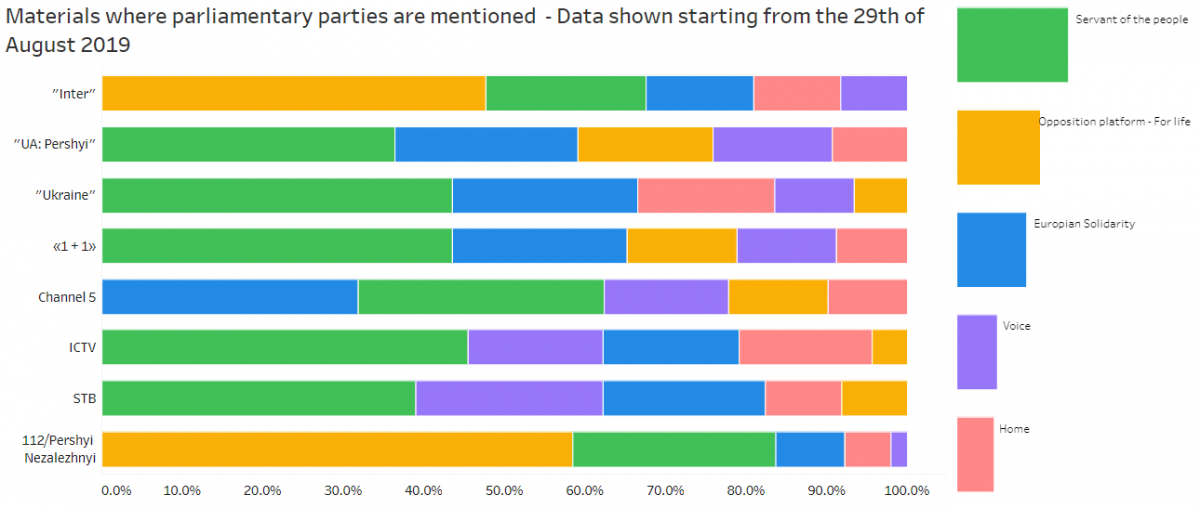
Which parliamentary parties were mentioned the most in the TV news of eight channels. January 2022. https://detector.media/page/newsboard/
Materials with signs of advertorial
Leaders among the participants in such materials are the Opposition Platform - For Life party and Rinat Akhmetov. Among the channels, Inter and Ukraine got the highest score in this anti-rating. From time to time, both the actors and the channels changed each other in the leading position. It was expected that the platforms for the Opposition Platform - For Life party's PR are the First Independent Channel and Inter, which belong to the party members, and for Rinat Akhmetov's PR it is his channel Ukraine. At the same time, materials with signs of promotion of their interests once appeared in atypical media: ICTV promoted the Opposition Platform - For Life party, and Akhmetov's business was promoted on Channel 5. This can be explained simply by looking at the context. Women's movements and forums are actively covered on ICTV, for which they are honored and praised. But the editorial board's attention is mainly on events involving First Lady Olena Zelenska, Vice Speaker Olena Kondratyuk or the Olena Pinchuk Foundation. And once they noticed Yulia Liovochkina. Therefore, despite the important topic of women's leadership, we recorded in the ICTV news PR by a female member of parliament of the Opposition Platform - For Life party, as no other participants in the event were included in the material. In a similar situation was the material by Channel 5, which told how the government of laymen (unlike its predecessors!) destroyed energy sector, and DTEK's structures are its only hope.
The interests of the Opposition Platform - For Life party on the First Independent channel also included all materials that manipulatively described the oppression of freedom of speech in Ukraine due to the blocking of pro-Russian media. The names of party members, Medvedchuk or his partners were not always mentioned in such materials, but there was a clear ideological line. Therefore, the amount of the PR and the number of direct mentions of the Opposition Platform - For Life party on the First Independent differs.
Among the mono-favorites of some channels is Arseniy Yatsenyuk, who is systematically mentioned in the most positive light on the Ukraine channel. In particular, he used the informational occasion of additional threats on the Ukrainian border - the migrants on the Belarusian side, the gathering of Russian troops - and reminded of the importance of his once forgotten Wall project. Also on Ukraine channel, a variety of topics are often commented on by extra-parliamentary politician Oleh Liashko who lost the majoritarian elections in 2020, although the Ukraine channel convinced of his undoubted leadership and threw mud at his rival. Inter also has its own speakers "on duty" for manipulative news. For example, it is Serhiy Kaplin. The forgotten ex-MP also regularly criticizes on the channel the weaknesses of the Ukrainian economy, pension system or social protection - topics that are exploited by the Opposition Platform - For Life party. In addition, Inter constantly talked about the shares of the Firtash's Regional Gas Company, disseminated news about the interests and initiatives of the DF Group, but kept silent about the accident at one of its enterprises
Inter and the Pershyi Nezalezhnyi became key channels loyal to the Church of the Moscow Patriarchate. They not only covered various holidays, but also disseminated the actual political statements of the leaders of the branch of the Russian Church in Ukraine. "We have a common problem that since 2014, churches and religious communities belonging to the Ukrainian Orthodox Church have been unlawfully and illegally seized," MP Oleksandr Bakhov complained in February. And Metropolitan Pavlo has said already in July: "Next, we adopted an appeal to the President of Ukraine to put an end to the atrocities that often occur in our society against the canonical holy church under the rule of His Beatitude Metropolitan of Kyiv and All Ukraine Onufriy." Other pro-Russian narratives were also characteristic of the the Pershyi Nezalezhnyi channel: from the promotion of the Russian vaccine to the terms of the peace plan on Medvedchuk's terms, with statements very much in agreement with the Russian position recognizing the subjectivity of the "republics" invented by the occupiers in Donetsk and Luhansk.
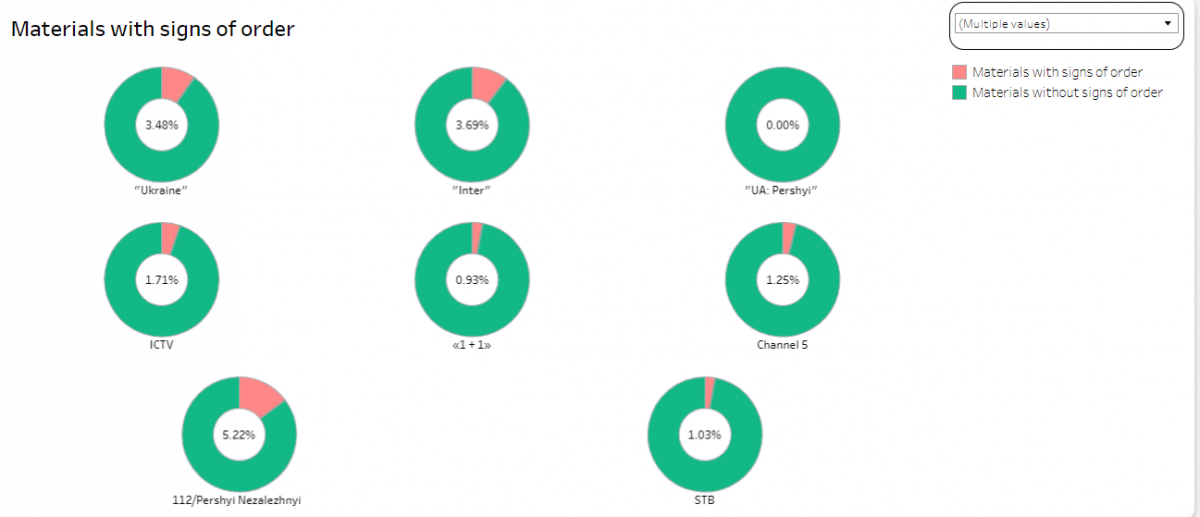
What percentage of television news showed signs of advertorial on each of the eight channels. Data from February 2019 to January 2022 https://detector.media/page/newsboard/
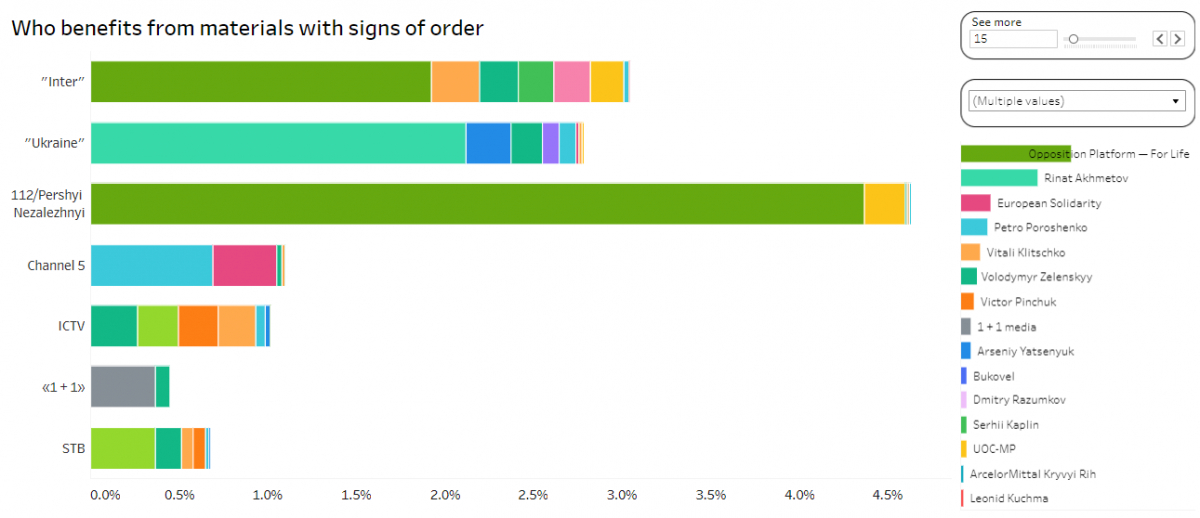
Parties and/or organizations that benefited from bespoke materials on each channel. Data from February 2019 to January 2022. https://detector.media/page/newsboard/
Channels Inter, Ukraine and ICTV were the least picky in the PR figures: here they could simultaneously talk about the Great Construction program as an achievement of President Zelenskyi and give the floor to his critics from the Opposition Platform - For Life party, the Batkivshchyna party or the European Solidarity party. And this phenomenon should not be confused with balance, because every single message was biased. Ukraine channel included comments by Oleksiy Kucherenko or Valentyn Nalyvaichenko, who criticized energy policy, apparently in line with Rinat Akhmetov's interests. On Inter, Batkivshchyna's leader Yulia Tymoshenko criticized the land market in unison with the Opposition Platform - For Life party. From time to time, ICTV reported on the advice given to the government by previous president Petro Poroshenko. ICTV and Inter were most loyal to Vitaliy Klychko who criticized the government, boasted about his excellence as mayor, and began his all-Ukrainian political tour.
If you look at Zelenskyi's presence in the materials with signs of promotion, then during the whole year they appeared to a bigger or lesser extend on every channel, except for UA:Pershyi. Indicative for the end of the year was the change in attitude towards Zelenskyi on the Ukraine channel (Yaroslav Zubchenko wrote about this in detail): back in the summer, presidential news was quite popular in Akhmetov's media, Zelenskyi's PR disappeared in the fall, and in the winter Akhmetov's channel even justified it by saying that they do not sow division among Ukrainians.
Political forces in news
As expected, the most popular party of the year was the Servant of the People – it is the largest in parliament, often expresses the position of the government, its representatives chair key committees, and therefore primarily comment on legislative changes. What is not very typical for the ruling party: there were only isolated cases outright native advertisement in the interests of the Servants of the People party, so the party is not in the top twenty of participants in the materials with signs of order. Probably, the reason here is the diversity of the party and the lack of a single headquarters that would deal with PR. With the expulsion of former speaker Dmytro Razumkov from the party, he got informational support on Channel Ukraine and Channel 5; before that, all channels were loyal to him, except for 1+1 and neutral Public Broadcaster.
ICTV, Ukraine and 1+1 were the most positive about Servants of the People party. And here again the context is important. Half of the party's positive mentions on ICTV fall on People's Deputy Dmytro Kysylevskyi, a native of Interpipe who continues to support industrial and educational initiatives of this company belonging to Viktor Pinchuk (ICTV owner). In the news of channel Ukraine, he also appeared in the context of the demands by the Ukrmetalurhprom group to restore the capacity of Ukrainian metallurgy (one of the key players in this area is Rinat Akhmetov, the owner of the channel Ukraine). In the autumn, Lyudmyla Buimister, a People's Deputy from Servants of the People party, who criticized the anti-oligarchic law and was later expelled from the party, became more frequent on channel Ukraine.
And on 1+1 the attitude to Servants was as vivid as the party itself. In the beginning, the "Servants" were criticized in connection with the elections in Prykarpattia, where the candidate from the government Vasyl Virastyuk still managed to win the battle with Oleksandr Shevchenko who is close to Ihor Kolomoiskyi. The biggest critics of the ruling party were Channel 5 and the Pershyi Nezalezhnyi. On the Channel 5, Zelenskyi's party was flogged on any (often appropriate) occasion, but in a biased way. And in the Medvedchuk-Shufrych media, the authorities were mostly accused of destroying freedom of speech.
The Opposition Platform - For Life party was the least covered by Pinchuk's channels - ICTV and STB. But most often, as expected, the party was quoted where it was most promoted: In each parliamentary report on Inter, the opinion of the Boyko-Rabynovych-Medvedchuk party was added, and the footage with Ukrainian PACE delegation included mostly representatives of the Opposition Platform - For Life party, who represented not so much the state's position as the party's one. The difference between the Opposition Platform - For Life party format of Inter and the Pershyi Nezalezhnyi channel was in the faces. Boyko, Korolevska, Liovochkin and the Odesa branch of the party were more desirable on Inter, while Medvedchuk, Rabynovych and Kyva were more desirable at the Pershyi Nezalezhnyi channel.
In some periods, the European Solidarity party was ahead of the Opposition Platform - For Life party in terms of mentions, although in annual terms it is way behind them. In the last month of the year, the increase in the number of mentions of Poroshenko's party was due to criminal cases in which he was involved. And if earlier Channel 5 tried to refrain from promoting the interests of its (formally former) owner directly, in the second half of the year the imbalance in favor of the European Solidarity party or its leader became the norm.

What is the percentage of specific politicians mentioned in the materials on each TV channels. Data from February 2019 to January 2022. https://detector.media/page/newsboard
The European Solidarity party and the Voice party began to appear more often on channel Ukraine at the end of the year. The Voice party began to shine more on the Channel 5, and it all looked like an additional increase in criticism of the government. But on Pinchuk's channels, Kira Rudyk's party is now less and less present, although ICTV and STB were the channels that promoted the Voice party - not very often, but regularly. By the way, the split in the party was covered sluggishly, and the next round of the conflict in December was almost ignored.
While the Voice party made headlines through political activism and truly important statements about defense, education and healthcare, Batkivshchyna looked inert in the news. In some periods, the party almost disappeared from the view of journalists and returned with Yulia Tymoshenko's program statements about referendums, land or the inadmissibility of legalizing cannabis (sometimes it all came together in one speech). Such news with statements often had either signs of order or overshadowed the political interests of media owners. It seems that at the end of the year Tymoshenko managed to take a less banal coverage opportunity and played the drums. From the sample of Detector Media, this was reported only on the channel Ukraine.
The For the Future factions rarely appears in parliamentary news, as the smallest parliamentary group so far. October became the richest in the mentions of this political force due to the death of People's Deputy Anton Poliakov and attention to clarifying its circumstances. Frankly negative attacks on the For the Future party were on Channel 5, where the party was called Kolomoiskyi's For Maybach project. And 1+1 was the most loyal to the representatives of the For the Future party – Ihor Palytsia's statements were spread here, quite local political news of Volyn was covered purely from the position of local top officials from this party, or populist statements.
Main and untold topics
National politics and social issues fought for the most attention. As in the previous year, this year, a big share of the news was about emergency events. This was due not only to the classic "emergencies" - accidents, tragedies and cataclysms - but also to changes during the Coronavirus epidemic: introduction of restrictions, outbreaks of the disease, deaths.
The most politicized month was March, when a number of political decisions on vaccination were made, parliamentary by-elections were held in Prykarpattia and Donetsk, and a series of high-profile meetings of the National Security and Defense Council took place. And the most social month was July, when the political season was paused, and a significant part of Ukrainians were on vacation or at least dreaming about it. At the same time, some channels - 1+1 and STB - regardless of the weight of the news, usually preferred social issues to political ones, apparently based on the interests of their audience. Also, in the annual statistics of the channel Ukraine, social issues prevailed over political ones, but in some periods, politics still came to the foreground.
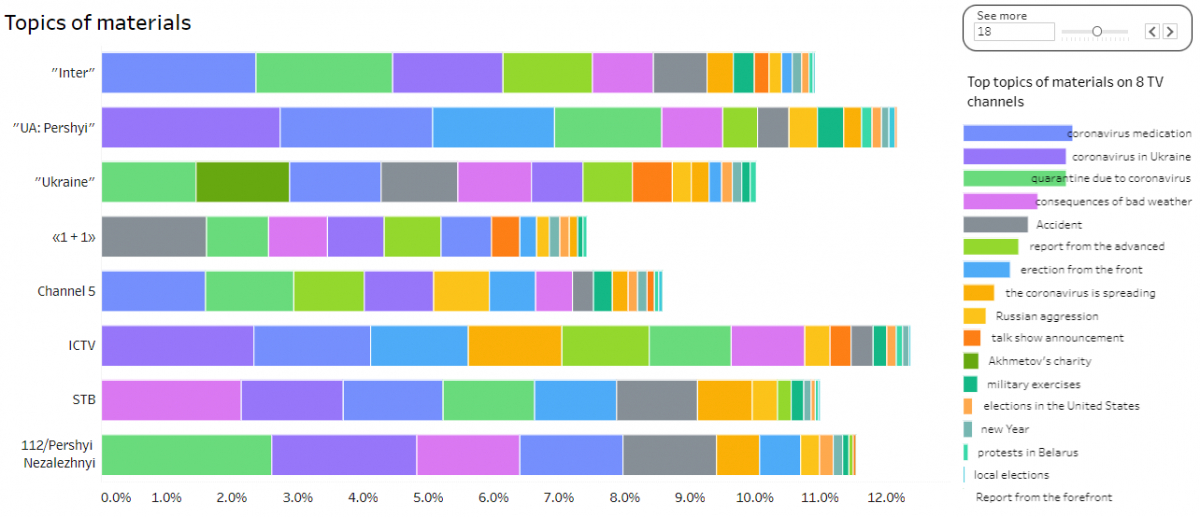
TOP-18 popular news items in the materials of TV channels. Data from February 2019 to January 2022. https://detector.media/page/newsboard/
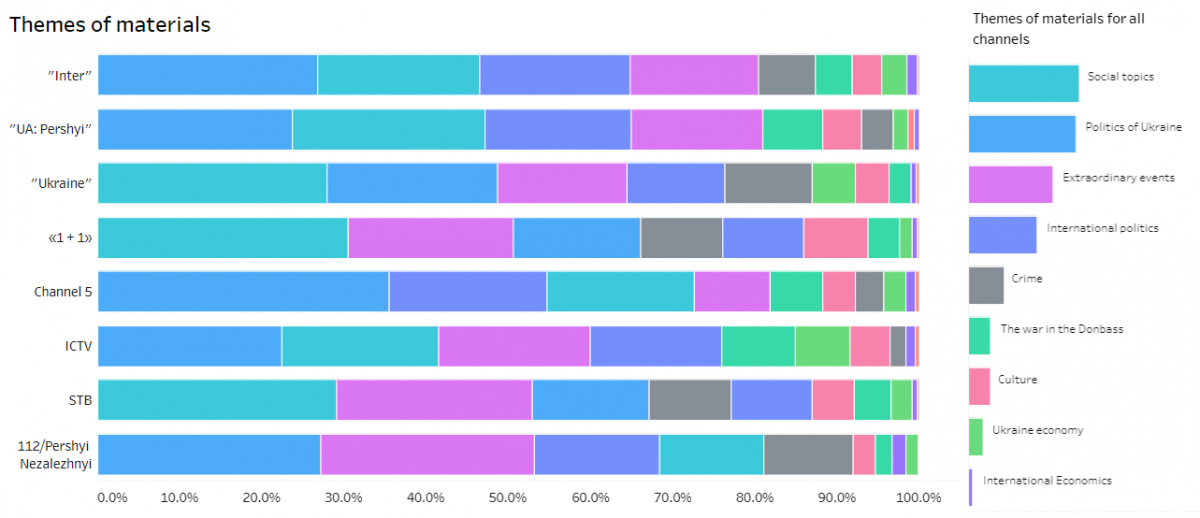
What temes were broadcast on eight TV channels. Data from February 2019 to January 2022. https://detector.media/page/newsboard/
The situation at the front was the least talked about on the Pershyi Nezalezhnyi. For weeks, there were no reports from the front at all in the prime-time news, even when there were shellings that affected civilians and the military. But the news about "negotiator Medvedchuk" as the only hope for the peaceful Donbas was present on this channel. The Pershyi Nezalezhnyi was the most passive in covering Russian aggression; it was concealing important diplomatic victories of Ukraine, such as the Crimean Platform. But it has repeatedly circulated statements by Russian officials accusing the Ukrainian authorities or alleging that Russia is not involved in the war in the Donbas. Newscasts of the Pershyi Nezalezhnyi were mostly filled with brief reports of emergencies and criminal events that were more like imitations of news, replaced by press releases by emergency workers or other media.
In general, the omission of important events is not very common in television news – this is absurd given the openness of information and the large number of media outlets that report things others have been silent about. Therefore, mostly such events were silenced in part. An example is the story of Zelenskyi's offshore accounts, when offshore was mentioned in the news in general, but Zelenskyi was not mentioned much. The coverage of Wagnergate, which was mostly shown on Channel 5, was indicative, presenting it as a great failure of government, while most channels maneuvered from selective coverage to almost complete disregard.
Most of the news in international politics came at the end of the year, when world leaders were concerned about building up Russian army on the border with Ukraine. The same outbreak of attention to international news and the war in the Donbas simultaneously occurred in April, during another period of aggravation. Other international events were mostly reported by Inter, which has a strong pool of foreign fans, as well as Channel 5 and the Public Broadcaster.
Geography of news
The consequences of bad weather or road accidents are perhaps the most popular news item for regional news. Obviously, in order to interest the editorial office, something extraordinary or revealing has to happen in the region. The top regions in terms of frequency of making it to the main TV news are cities with a population of over one million, where there are more events and the news offices are stable. The undisputed leader is the Donetsk region, as it appears daily in most issues due to the front line. Reports of military correspondents from the Donetsk region occur more often than materials from the Luhansk region. The Kharkiv region took the second place, but gained such popularity not only due to the mayoral election, which took place there in late October. Only in November there were several high-profile car accidents, and one of them - with a underage driver behind the wheel. Due to the resonant accident, the surge of news activity in December reached the Chernihiv region, where a tragic accident with a public minibus occurred on the highway.
Lviv, Kharkiv, Dnipro and Odesa most often appeared in a series of live broadcasts or collective materials from the regions, which revealed the chronicles of the epidemic, hospital problems, local government decisions on quarantine and the reaction of citizens to restrictions. Coronavirus statistics and a high level of infection rates in February-March attracted a lot of attention to Prykarpattia, and in October - to the Kherson region, which became the first "red" region of the next wave.
Due to the build-up of Russian troops to the Ukrainian border, news from Russia increased at the end of the year. Also in November, the Volyn region, which was usually forgotten by journalists, received the most attention - also thanks to border guards who told how the crisis on the Belarusian-Polish border affects the security of the Ukrainian border. Despite this, the border Sumy region in some weeks fell out of the news.
Crimea has also often dropped out of the mainstream news for weeks. Most of the news comes from there through other media or social networks, and in general journalists have little interest in the events on the occupied peninsula. June was the most fruitful for Crimean news. Then they covered the consequences of flood in resort towns, as well as the emergence of the British destroyer to the Crimean coast. Most of the news from Crimea during the year concerned political repression, Russian aggression and the aftermath of the storm. UA:Pershyi informed about these events most actively, channel Ukraine, 1+1, and Channel 5 were almost equally attentive to them.
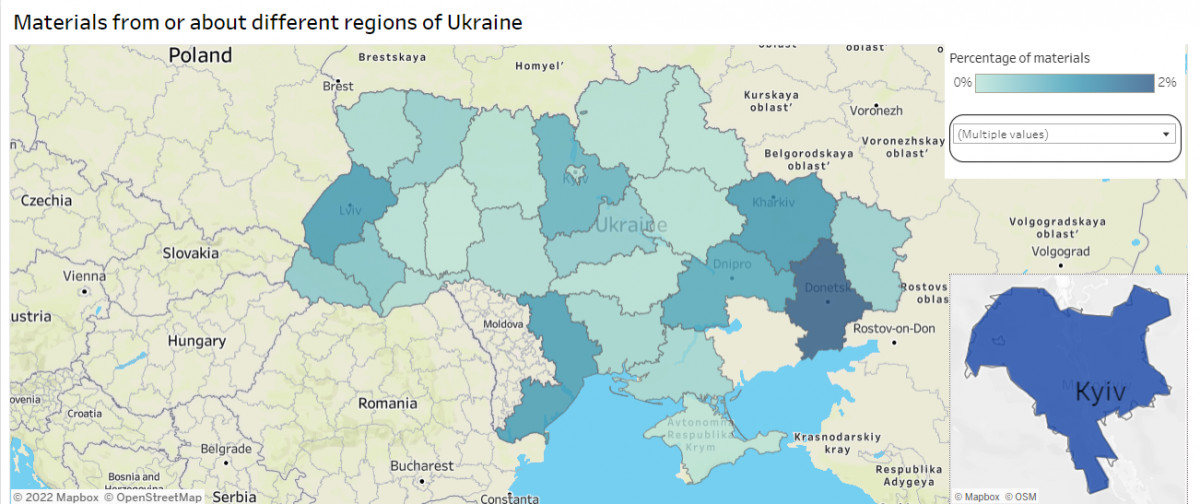
The amount of material devoted to events in certain regions. Data from February 2019 to January 2022. https://detector.media/page/newsboard/
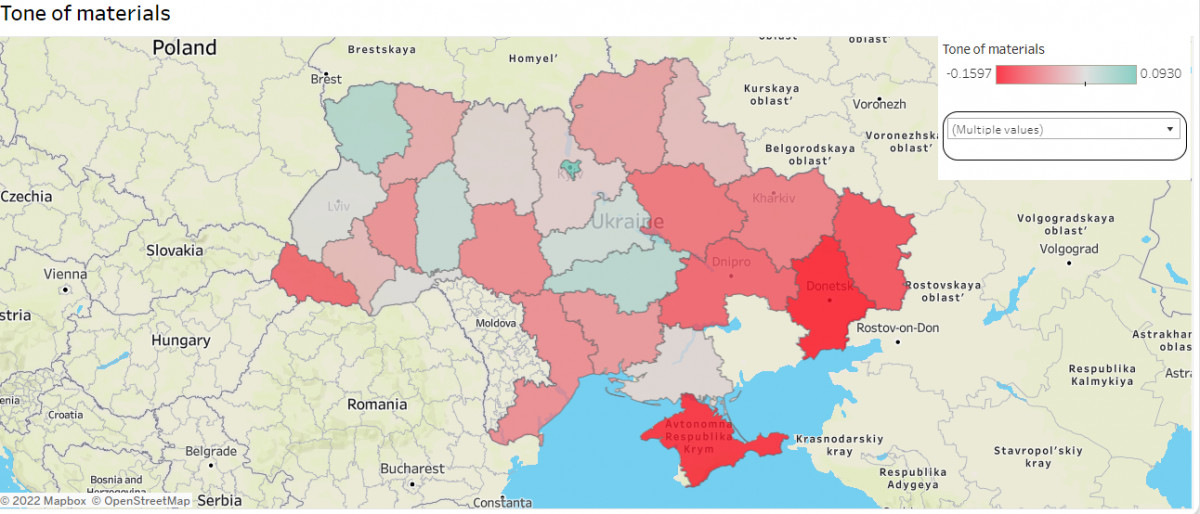
The tone of the materials from February 2019 to January 2022 on eight central TV channels dedicated to events in certain regions. Red - is negative. Green - positive. https://detector.media/page/newsboard/
Standards in the news
The biggest problems in separating facts from comments occur usually in the news by channel Ukraine, STB and 1+1, but since September, the indictor on Channel 5 has deteriorated significantly. The reason is Vitaliy Kovach, the new host of the prime-time newscast. His introductions can be seen as a separate genre of stand-up comedy, especially if the news is political. Among Mr. Kovach's most ardent speeches was sarcasm about "roshenka": "Eating roshenka [products by Roshen] means you support Putin, buying electricity in Russia means you save the country"; political analysis of Zelenskyi's speech: "I hope that by the end of the term we will not lose the country"; and assessment of needs of Ukrainians:: "Money can be obtained through the Diya application. But you will not be able to dispose of them as you wish. That means that you can't buy a naggin, and a snack as well." We would like to remind that news is a genre in which the personal opinion of a journalist or presenter is inappropriate, and if he still resorted to it, he must clearly authorize it.
This year, the news by the Pershyi Nezalezhnyi was most unbalanced. This often happened due to one-sided complaints about alleged oppression of freedom of speech. For the same reason, there are most inaccuracies when the facts were distorted to make them look more convincing. For example, in February, each news release began with the phrase: "N days since President Zelenskyi blocked Channel 112, Newsone and ZIK because they were telling the truth," which is untrue. Or they distorted the statements of foreign politicians or foreign media in their favor, as was the case with the publication in The National Interest (analysis of this manipulation is here). In general, gross violations of the standard of accuracy are a very unusual phenomenon, so our monitoring records them in the prime news infrequently.
The Pershyi Nezalezhnyi also lacked balance and completeness when quoting statements by Russian officials without putting them in the proper context. Especially in the first months of the appearance of the Pershyi Nezalezhnyi after the blockade of Medvedchuk's previous media assets, the news here was very lacking credibility: the presenters read the short messages without reference to the sources, like a regular digest, not a full-fledged newscast. Towards the end of the year, citing news sources became more common, but the channel's reliability is still the worst of all. Therefore four of the six basic standards are met on the Pershyi Nezalezhnyi worst of all eight television channels, which guarantees the news program of this channel the status of the worst news of the year.
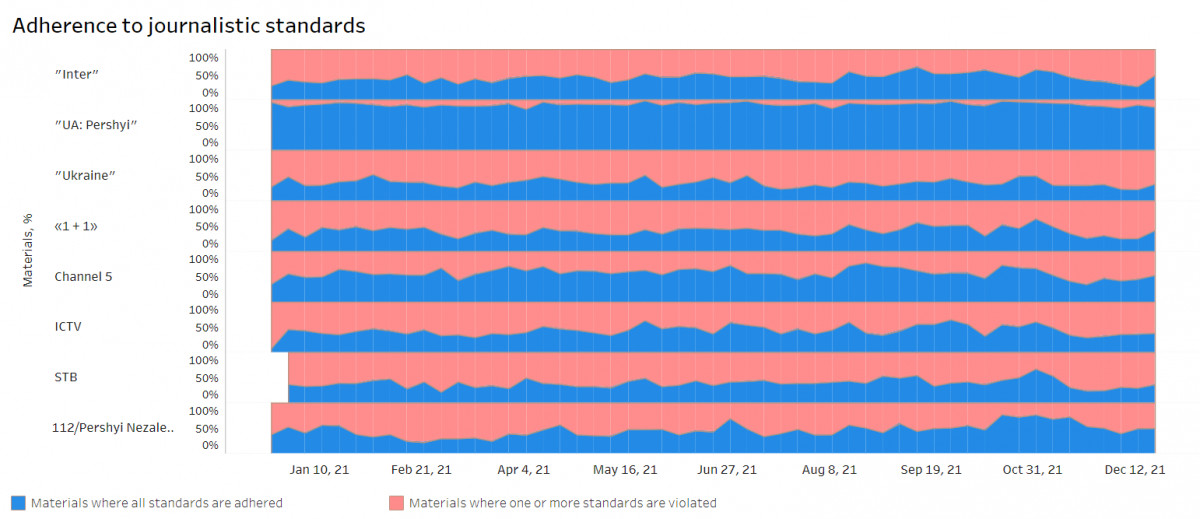
The ratio of the share of materials where all six journalistic standards were met and the share of materials where at least one of the standards was violated. Data from 10.01.21 to 31.12.21р. https://detector.media/page/newsboard/
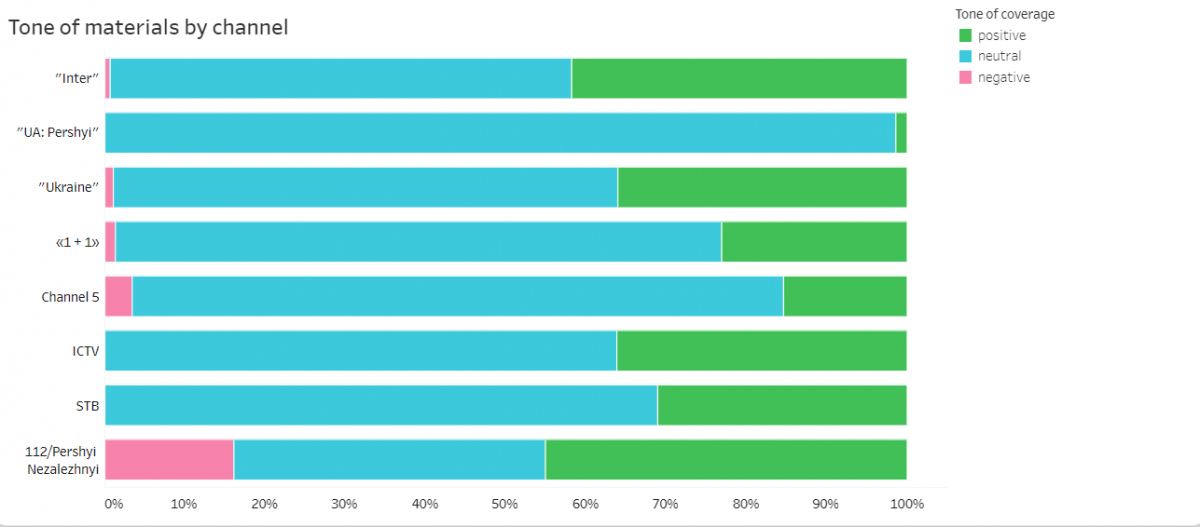
What percentage of the channel's materials have a positive, neutral or negative tone of news coverage. Date from February 2019 to January 2022. https://detector.media/page/newsboard/
This report was submitted by Detector media NGO with the support of the United States Agency for International Development (USAID). The study was made possible thanks to the sincere support of the American people, provided through the United States Agency for International Development (USAID). The product content is solely Detector media NGO and does not necessarily reflect the views of USAID or the US Government. Reproduction and use of any part of this product in any format, including graphic, electronic, copying or use in any other way without the corresponding reference to the original source, shall be prohibited.
The tables used in the report are taken from the NewsBoard interactive panel developed by the Detector Media NGO as part of the Public Television Monitoring and Information Panel project with the support of the United States Agency for International Development (USAID).
NewsBoard is based on monitoring materials from the Detector media NGO and its Monitoring Database, which was made possible by the financial support of the United States Agency for International Development (USAID) through the Media Program in Ukraine project implemented by the international organization Internews. The contents of this publication are the sole responsibility of Media Detector and do not necessarily reflect the views of USAID, the US Government or Internews.






